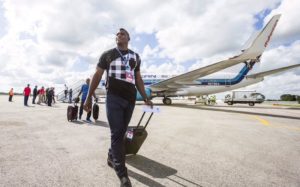 CUBA “GIVE A TURN TO THE NUT” TO CUBAN MIGRANTS WHO WANT TO RETURN.
CUBA “GIVE A TURN TO THE NUT” TO CUBAN MIGRANTS WHO WANT TO RETURN.
Among the experts of the ballet, the Cuban Rolando Sarabia used to be compared to legends such as Vaslav Nijinsky and Mikhail Baryshnikov, although for those who are not dancers, his name made headlines when he left the island in 2005 and began his career in the United States.
Until last week, when he played the male lead of “Giselle” during a stellar night of the XXVI International Ballet Festival, he had not appeared in Cuba for 14 years as part of a kind of veto that marked many artists who left the island.
His arrival, that of his brother – the dancer also, Daniel Sarabia – and other renowned artists such as Taras Domitro, Marizé Fumero and Carlos Quenedit, formerly members of the BNC, is a sample of the scope of a policy of reconciliation between the nation Caribbean and its hundreds of thousands of emigrants around the world.
In ballet, sports and some sectors such as health and education Artists and athletes were marginalized when they decided to emigrate, especially in the heat of the economic crisis that hit the island in the 90s and their departures were often politicized both from Cuba as per sectors in the United States.
Cuba eliminated the requirement of a permit to leave the country for its citizens in 2013. The immigration reform triggered a flow of travel with tens of thousands of people leaving annually, retaining their political and especially social rights such as health and education if they return to the country. less briefly every two years. Cuba’s relationship with its citizens abroad remains tense and painful in many cases, especially for families who left the country during the toughest moments of the revolution.
However, now it seems that the migratory situation begins to change.
Since 2013 some 40,000 islanders requested their repatriation while official cultural and sports institutions began to open their doors to many personalities who had left. Musicians like Salsa Issac Delgado, troubadour Pancho Céspedes or Decemer Bueno returned to live or perform in Cuba and baseball players who went to the United States as Yasiel Puig, José Abreu, Alexei Ramírez and Brayan Peña returned for official exhibitions.
Other emigres did not come to dance but to teach – like the former Boston Ballet star, Lorna Feijóo – but the emotion is shared equally.
Taras Domitro, who left the group during a tour of Canada in 2007 and crossed the border with the United States, thinks it is “an honor” to dance again in Cuba.
At the time the legendary Alicia Alonso – creator of BNC and who heads the company at 96 years old – addressed harsh words to the young people who left the company or left the presentations when they went abroad. He even compared them to “kites” that were going to fly without string.
Officials consulted by AP (The Associated Press) who are not authorized to comment on details of the process with the press indicated that the invitation to these dancers began to take shape a couple of years ago and that some of them signed a letter requesting to return to the stage.
The rapprochement between Cuba and its diaspora had a twist in the past months: in a meeting with residents in Washington in October 2017, Foreign Minister Bruno Rodríguez reported on a new package of socks that facilitates the return trips of the emigrants and recognizes citizenship for their children. The new president Miguel Díaz-Canel went even further during his first trip to the United States, home to more than one and a half million Cubans.
Between January 2013 and the same month of 2018 there were two million entries of Cubans living abroad, of which one and a half million coming from the United States, explained Díaz-Canel.
For experts in ballet, the return of dancers trained on the island who had experiences in other latitudes is an advantage also for the Cuban school itself, known for its traditionalism. “The return is very important,” said the writer and ballet lover, Julio César Pagés.
“Nobody owns the absolute truth, perhaps forgiveness or reintegration is the best process Cuba can live. We have had too many dilemmas with the emigration and that they come back is also part of a good time, “he added.
 CUBA “DA UNA VUELTA DE TUERCA” A LOS EMIGRADOS QUE QUIEREN REGRESAR.
CUBA “DA UNA VUELTA DE TUERCA” A LOS EMIGRADOS QUE QUIEREN REGRESAR.
Entre los expertos del ballet, el cubano Rolando Sarabia solía ser comparado con leyendas como Vaslav Nijinsky y Mikhail Baryshnikov, aunque para aquellos ajenos a la danza su nombre saltó a los titulares cuando abandonó la isla en 2005 y comenzó su carrera en Estados Unidos.
Hasta la semana pasada, cuando interpretó el protagónico masculino de “Giselle” durante una noche estelar del XXVI Festival Internacional del Ballet, llevaba 14 años sin presentarse en Cuba como parte de una suerte de veto con el que se marcó a muchos artistas que dejaban la isla.
Su arribo, el de su hermano –el también bailarín, Daniel Sarabia– y otros renombrados artistas como Taras Domitro, Marizé Fumero y Carlos Quenedit, otrora miembros del BNC, es una muestra de los alcances de una política de reconciliación entre la nación caribeña y sus cientos de miles de emigrados en todo el mundo.
En ballet, el deporte y algunos sectores como la salud y la educación Artistas y atletas quedaban marginados cuando decidían emigrar, sobre todo al calor de la crisis económica que golpeó a la isla en los años 90 y sus salidas muchas veces se politizaron tanto desde Cuba como por sectores en Estados Unidos.
Cuba eliminó el requisito de un permiso de salida del país para sus ciudadanos en 2013. La reforma migratoria desató un flujo de viajes con decenas miles de personas que salen anualmente conservando sus derechos políticos y sobre todo sociales como la salud y la educación si regresan al menos brevemente cada dos años. La relación de Cuba con sus ciudadanos en el extranjero sigue siendo tensa y dolorosa en muchos casos, especialmente para las familias que abandonaron el país durante en los momentos más duros de la revolución.
Sin embargo, ahora parece que la situación migratoria empieza a cambiar.
Desde 2013 unos 40.000 isleños solicitaron su repatriación mientras instituciones culturales y deportivas oficiales comenzaron a abrir sus puertas a muchas personalidades que se habían ido. Músicos como el salsero Issac Delgado, el trovador Pancho Céspedes o Descemer Bueno regresaron a vivir o a actuar en Cuba y jugadores de béisbol que se fueron a Estados Unidos como como Yasiel Puig, José Abreu, Alexei Ramírez o Brayan Peña volvieron para exhibiciones oficiales.
Otros emigrados no vinieron a bailar sino dar clases –como la antigua estrella del Boston Ballet, Lorna Feijóo– pero la emoción se comparte por igual.
Taras Domitro, quien abandonó la agrupación durante una gira por Canadá en 2007 y cruzó la frontera con Estados Unidos, piensa que es “un honor” volver a bailar en Cuba.
En su momento la legendaria Alicia Alonso –creadora de BNC y quien encabeza la compañía a sus 96 años–, dirigió palabras duras a los jóvenes que abandonaban la compañía o dejaban plantadas las presentaciones cuando salían al exterior. Incluso los comparó con “papalotes” que se iban a volar sin cordel.
Funcionarios consultados por AP (The Associated Press) que no están autorizados a comentar detalles del proceso con la prensa indicaron que la invitación a estos bailarines comenzó a gestarse hace un par de años y que algunos de ellos firmaron una carta solicitando volver a los escenarios.
El acercamiento entre Cuba y su diáspora tuvo una vuelta de tuerca en los meses pasados: en un encuentro con residentes en Washington en octubre de 2017, el canciller Bruno Rodríguez informó sobre un nuevo paquete de medias que facilita los viajes de regreso de los emigrados y reconoce la ciudadanía a sus hijos. El nuevo presidente Miguel Díaz-Canel fue incluso más allá durante su primer viaje a Estados Unidos, hogar de más de un millón y medio de emigrados cubanos.
Entre enero de 2013 y el mismo mes de 2018 se registraron dos millones de entradas de cubanos residentes en el extranjero, de ellas un millón y medio procedentes de Estados Unidos, explicó Díaz-Canel.
Para los expertos en ballet, el regreso de bailarines formados en la isla que tuvieron experiencias en otras latitudes es una ventaja también para la propia escuela cubana, conocida por su tradicionalismo. “Es muy importante el regreso”, comentó el escritor y amante del ballet, Julio César Pagés.
“Nadie es dueño de la verdad absoluta, quizá perdonar o reintegrar es el mejor proceso que puede vivir Cuba. Nosotros hemos tenido demasiados dilemas con la emigración y que ellos regresen forma parte también de un buen momento”, agregó.
Agencies/AP-Associated Press/ Excerpts/ Internet Photos/ Arnoldo Varona/ TheCubanHistory.com
THE CUBAN HISTORY, HOLLYWOOD.









